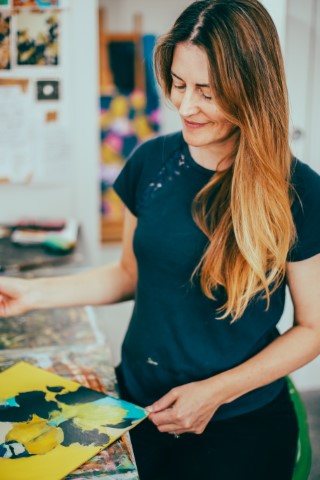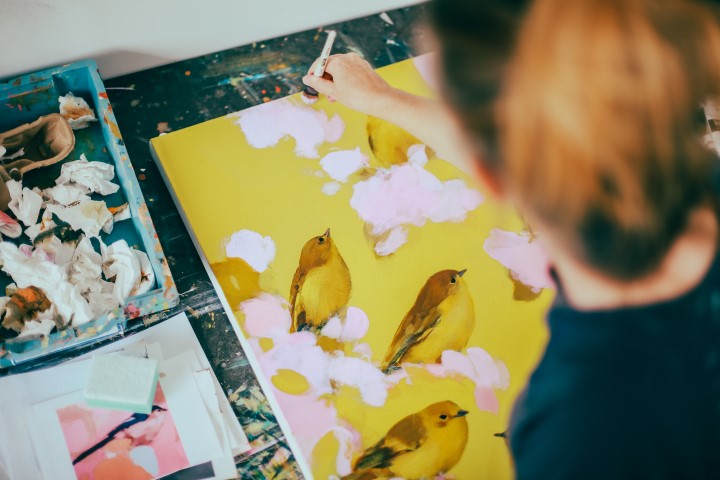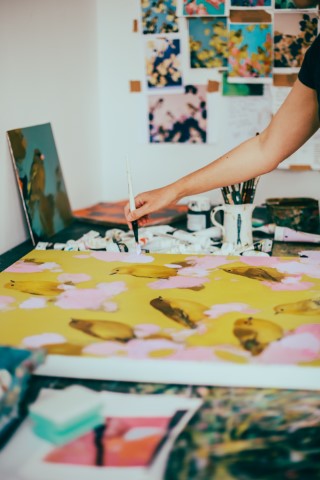 Can you share a bit about your artistic journey and what inspired you to pursue art as a career?
Can you share a bit about your artistic journey and what inspired you to pursue art as a career?
I began my artistic career by chance. In 1999, I came across an art department and saw brushes, paints and canvas and felt instantly lifted. I decided then I wanted to become an artist. I had no idea how to do this but was fortunate in that I became involved with a community of painters establishing an artists’ quarter on Brighton seafront. After many years of painting still life and landscapes, I found that what I loved to paint was birds. I would often walk my dog and notice birds, but it wasn’t until 2007 that I started to paint them.
What themes or concepts do you explore in your work, and why are they important to you?
At first, I painted birds alone in white, opaque backgrounds but these progressed to become vibrant and colourful. My paintings began to express themes of joy in friendship, togetherness and kinship, with the birds appearing domesticated.
Could you describe your creative process from start to finish? Do you have any rituals or habits that help you get into the creative zone?
I work from photographs and love to repeat painting the same bird. I find that, as I work by sight with little drawing, the bird always looks different. I often work on board. First I cut the board from a bigger sheet; prime and sand it. Such a smooth surface allows the paint to glide and gives the chance for more detail.
 What mediums do you primarily work with, and why do you find them particularly suited to expressing your ideas?
What mediums do you primarily work with, and why do you find them particularly suited to expressing your ideas?
I love acrylics. Their heavy nature and super vibrancy allows a painting to change quickly, with compositional and colour changes almost instantly.
Are there any artists or movements that have influenced your style or approach to art? How do you incorporate these influences into your own work?
I have been heavily influenced by the rules of Chinese painting, where the theory of special composition methods helps me construct paintings. I have tried to marry this with my love for colour. I have a print of the painting A Young Girl Reading (1776) by Jean Honore Fragonard on my wall from the Rococo period. The exuberance of colour in her dress and face, I find, truly mesmerising. I would love to see this painting in real life.
 Many collectors are drawn to art that evokes emotion or tells a story. Can you share the story behind one of your pieces that holds special meaning to you?
Many collectors are drawn to art that evokes emotion or tells a story. Can you share the story behind one of your pieces that holds special meaning to you?
I do not keep my own work, but I do still own a small painting of a warbler in a sort grey and butter yellow. I gave it to my husband as something about it, maybe the way the bird is sitting or how the colours cradle it, makes me feel it is totally harmonious with itself. It feels peaceful which is a quality I try to achieve in all my work.
What do you hope viewers take away from experiencing your art, both aesthetically and emotionally?
I hope that viewers take away more of an interest in birds and that the next time they hear one, maybe they will take the time to look up and observe. I find it gives me the excuse to stop what I am doing and thinking and, if only for a second, it provides a much needed respite from all the noise of the world.
 Can you share a bit about your artistic journey and what inspired you to pursue art as a career?
Can you share a bit about your artistic journey and what inspired you to pursue art as a career? What mediums do you primarily work with, and why do you find them particularly suited to expressing your ideas?
What mediums do you primarily work with, and why do you find them particularly suited to expressing your ideas? Many collectors are drawn to art that evokes emotion or tells a story. Can you share the story behind one of your pieces that holds special meaning to you?
Many collectors are drawn to art that evokes emotion or tells a story. Can you share the story behind one of your pieces that holds special meaning to you?